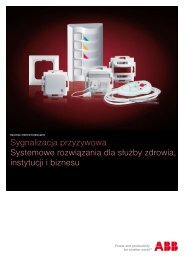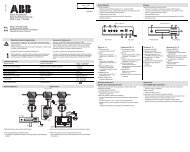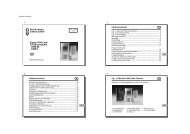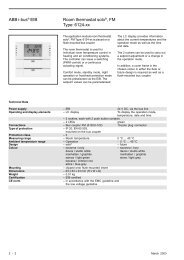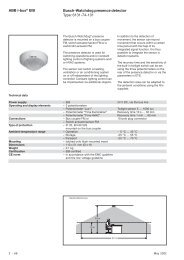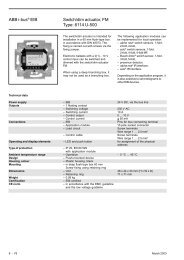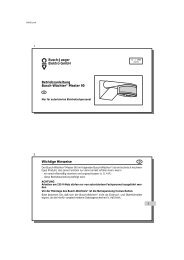ABB i-bus® EIB Watchdog sensor 180 comfort with multi-lens, FM ...
ABB i-bus® EIB Watchdog sensor 180 comfort with multi-lens, FM ...
ABB i-bus® EIB Watchdog sensor 180 comfort with multi-lens, FM ...
You also want an ePaper? Increase the reach of your titles
YUMPU automatically turns print PDFs into web optimized ePapers that Google loves.
<strong>ABB</strong> i-bus ® <strong>EIB</strong><br />
<strong>Watchdog</strong> <strong>sensor</strong> <strong>180</strong> <strong>comfort</strong> <strong>with</strong> <strong>multi</strong>-<strong>lens</strong>, <strong>FM</strong><br />
Type: 6122-xx<br />
The watchdog <strong>sensor</strong> application module<br />
is placed on a flush-mounted bus<br />
coupler or switch actuator/<strong>sensor</strong>.<br />
In addition to motion detection, the <strong>sensor</strong><br />
can pick up movement <strong>with</strong>in a certain<br />
period using its integrated monitoring<br />
function. It is therefore possible to<br />
integrate the <strong>sensor</strong> in event signalling<br />
systems.<br />
The movement detector also has a<br />
photo-electric <strong>sensor</strong> function. This<br />
function triggers telegrams when the<br />
brightness level exceeds or falls below<br />
set values.<br />
Using a slide switch, the movement detector<br />
can switch between the three<br />
operating modes ON / AUTOMATIC /<br />
OFF. The switch can be locked in the<br />
neutral position using the screw supplied.<br />
The recovery time and the sensitivity of<br />
the integrated photo-electric switch can<br />
be set using the two potentiometers at<br />
the back of the movement detector or<br />
via the parameters in ETS.<br />
It is also available <strong>with</strong> a <strong>multi</strong>-<strong>lens</strong> and<br />
modified detection range (see diagram).<br />
Technical data<br />
Power supply – <strong>EIB</strong> 24 V DC, via the bus line<br />
Operating and display elements – Slide switch<br />
– Potentiometer Photo-electric <strong>sensor</strong> 5 … 1000 Lx<br />
– Potentiometer Recovery time 10 s … 17 min<br />
Connections – Flush-mounted bus coupler or 10-pole plug connector<br />
– Flush-mounted switch actuator/<strong>sensor</strong><br />
Type of protection – IP 20, EN 60 529<br />
mounted on the bus coupler<br />
Ambient temperature range – Operation - 5 °C … 45 °C<br />
– Storage -25 °C … 55 °C<br />
– Transport -25 °C … 70 °C<br />
Design – solo ® – future<br />
Farbe – savanne / elfenbein – savanne / elfenbein<br />
davos / studioweiß<br />
davos / studioweiß<br />
manhatten / graphit<br />
manhatten / graphit<br />
samoa / hellgrün<br />
stone / lichtgrau<br />
toscana / purpurrot<br />
attica / taubenblau<br />
Mounting<br />
– latched onto flush-mounted unit<br />
Dimensions – 63 x 63 mm (H x W)<br />
Weight<br />
– 0.04 kg<br />
Certification<br />
CE norm<br />
– <strong>EIB</strong>-certified<br />
– in accordance <strong>with</strong> the EMC guideline<br />
and the low voltage guideline<br />
Normal detection range<br />
Detection range <strong>with</strong> <strong>multi</strong>-<strong>lens</strong><br />
2-68 March 2003
<strong>ABB</strong> i-bus ® <strong>EIB</strong><br />
<strong>Watchdog</strong> <strong>sensor</strong> <strong>180</strong> <strong>comfort</strong> <strong>with</strong> <strong>multi</strong>-<strong>lens</strong>, <strong>FM</strong><br />
Type: 6122-xx<br />
Application programs Number of Max. number of Max. number of<br />
communication objects group addresses associations<br />
For flush-mounted bus coupler:<br />
Switch Value Cyclic Monitoring Threshold /1 12 21 21<br />
For flush-mounted switch actuator/<strong>sensor</strong>:<br />
Switch Value Cyclic Monitoring Threshold /1 12 21 21<br />
Circuit diagram<br />
4<br />
1<br />
2 5<br />
3 6<br />
1 Bus cable 4 Adapter for adjustments<br />
2 Bus terminal 5 Slide switch<br />
3 Flush-mounted bus coupler 6 Application module<br />
March 2003 2-69
<strong>ABB</strong> i-bus ® <strong>EIB</strong><br />
<strong>Watchdog</strong> <strong>sensor</strong> <strong>180</strong> <strong>comfort</strong> <strong>with</strong> <strong>multi</strong>-<strong>lens</strong>, <strong>FM</strong><br />
Type: 6122-xx<br />
Switch Value Cyclic Monitoring<br />
Threshold /1<br />
<br />
<br />
Selection in ETS2<br />
– <strong>ABB</strong><br />
Phys. Sensors<br />
Movement<br />
Using this application program, the movement<br />
detector can pick up movement<br />
in its detection range and send switching<br />
or value telegrams.<br />
When assigning parameters, it should<br />
be noted that some parameters are<br />
only visible when “High Access” is selected<br />
and can only be modified at this<br />
point.<br />
The setting of the threshold for the light<br />
<strong>sensor</strong> as well as the recovery time can<br />
be carried out using the potentiometer<br />
at the back of the movement detector.<br />
There is also a separate setting aid.<br />
Alternatively, the settings can be carried<br />
out in ETS. To do this, the parameter<br />
settings should be changed from<br />
“Potentiometer” to “ETS”. With the parameter<br />
“Threshold”, it is possible to<br />
indicate which brightness value triggers<br />
the movement detector. The value “0”<br />
means dark while “255” means maximum<br />
brightness. The recovery time can<br />
be set <strong>with</strong> the two parameters “Time<br />
base of recovery time” and “Time factor<br />
of recovery time”. The base and factor<br />
are <strong>multi</strong>plied to produce the recovery<br />
time:<br />
Recovery time = Base * Factor<br />
The operating mode of the movement<br />
detector can be set via the slide switch.<br />
If the slide switch is moved into position<br />
“1”, the movement detector sends a “1”<br />
to its communication object “Movement<br />
/ Telegr. switch”. If it is moved into position<br />
“0”, it sends a “0”. The modified<br />
operating mode is thus transferred on<br />
the bus. In both cases, the monitoring<br />
function is inactive.<br />
The current status of the slide switch is<br />
sent on the bus via the object “Movement<br />
/ Activation”. It is therefore guaranteed<br />
that other movement detectors<br />
assume the operating mode simultaneously.<br />
Switch<br />
The movement detector sends switching<br />
telegrams to the communication<br />
object “Movement / Telegr. switch”<br />
when it picks up some movement in its<br />
detection range. The value of the switching<br />
telegram can be set <strong>with</strong> the parameter<br />
“Sending at detection”.<br />
It is possible to send an “ON telegram”,<br />
an “OFF telegram” or “no telegram”<br />
when movement is detected. The “ON”<br />
or “OFF” telegrams can also be sent<br />
cyclically.<br />
If the movement detector senses no<br />
further movement once the recovery<br />
time has elapsed, it is possible to send<br />
an “ON telegram”, an “OFF telegram”<br />
or “no telegram”. The “ON” or “OFF”<br />
telegrams can also be sent cyclically in<br />
this case. This is determined <strong>with</strong> the<br />
parameter “Telegram after recovery<br />
time”.<br />
It is also possible to disable the movement<br />
detector. The communication object<br />
“Movement / Activation” is used for<br />
this. It is visibly switched <strong>with</strong> the parameter<br />
“Activation object movement”.<br />
The movement detector is activated or<br />
deactivated if a telegram is received at<br />
this object. With the parameter “At ...<br />
movement”, it can be set whether an<br />
“ON telegram”, an “OFF telegram” or<br />
“no telegram” is sent once via the communication<br />
object “Movement / Telegr.<br />
switch”.<br />
Example:<br />
In a functional building, all the movement<br />
detectors are enabled in the<br />
morning at a specific time. To do this, a<br />
“1” is sent <strong>with</strong> a time switch to the control<br />
centre and received at the communication<br />
object “Movement / Activation”.<br />
In this example, the parameter “Enabling<br />
movement at” is set to “ON telegram”.<br />
Value<br />
It is also possible to send values when<br />
movement is detected. To do this, the<br />
parameter “Type of movement object”<br />
must be changed to “Value (EIS 6)”.<br />
Dimming actuators can for example be<br />
dimmed to a value that is smaller than<br />
the maximum value.<br />
The parameter settings “Sending at the<br />
beginning/end of the detection”, determine<br />
the size of the value that is sent.<br />
The option “no telegram” can also be<br />
selected.<br />
2-70 March 2003
<strong>ABB</strong> i-bus ® <strong>EIB</strong><br />
<strong>Watchdog</strong> <strong>sensor</strong> <strong>180</strong> <strong>comfort</strong> <strong>with</strong> <strong>multi</strong>-<strong>lens</strong>, <strong>FM</strong><br />
Type: 6122-xx<br />
Cyclic<br />
All switching telegrams can also be<br />
sent cyclically. It should be ensured<br />
that the setting “ON telegram cyclically“<br />
or “OFF telegram cyclically” is selected<br />
in the respective parameter.<br />
The total cyclic time can be set <strong>with</strong> the<br />
parameters “Time base for cyclical sending”<br />
and “Time factor for cyclic sending”.<br />
The cyclic sending interval for a telegram<br />
is calculated by combining the<br />
base and factor:<br />
Cyclic time = Base * Factor<br />
Monitoring<br />
It is possible to activate a monitoring<br />
function. To do so, the general parameter<br />
“Monitoring function” must be set to<br />
“yes”. The monitoring function represents<br />
a quasi alarm signal which is not<br />
triggered at the slightest thermal movement<br />
but only if a significant power<br />
source is registered in a short time period<br />
by the movement detector or several<br />
weaker sources are detected over a<br />
longer period.<br />
If the monitoring function is activated,<br />
there is a further communication object<br />
available “Signal / Telegr. ...”, which is<br />
independent of the photo-electric <strong>sensor</strong>.<br />
The device detects the intensity<br />
and amount of movement <strong>with</strong>in a time<br />
period and only sends telegrams once<br />
a specific sensitivity threshold has been<br />
exceeded. The parameter “Threshold”<br />
indicates the level of sensitivity. The<br />
value “255” denotes the maximum level<br />
of sensitivity while “0” indicates the minimum<br />
level.<br />
On a further parameter page “Monitoring<br />
function”, it is possible to select the<br />
type of the monitoring object<br />
(1 bit or 1 byte), the type of telegram at<br />
the start and end of the detection and<br />
the cyclical sending behaviour.<br />
If the monitoring function is to enabled<br />
externally, this can be carried out <strong>with</strong><br />
the communication object “Signal / Activation”.<br />
The parameter “Activation object<br />
monitoring” must previously be set<br />
to “available”.<br />
Pull off detection<br />
Pull off detection represents a further<br />
security function. If the movement detector<br />
is removed from the bus/mains<br />
coupler, it sends a “0” via its communication<br />
object “Pull off detection / Telegr.<br />
switch”. It is therefore possible to detect<br />
any possible tampering by thieves.<br />
Photo-electric <strong>sensor</strong><br />
It is also possible to activate a photoelectric<br />
<strong>sensor</strong> function. The general<br />
parameter “Photo-electric <strong>sensor</strong>” must<br />
be set to “yes”.<br />
On a further parameter page “Photoelectric<br />
<strong>sensor</strong>”, the type of the object<br />
can be set (1 bit or 1 byte) together<br />
<strong>with</strong> the value that is sent when the lower<br />
or upper threshold is reached as<br />
well as the cyclical sending behaviour.<br />
With the parameter “Ignore artificial light”,<br />
it is determined whether the movement<br />
detector only reacts to daylight<br />
or not.<br />
The parameters “Lower threshold” or<br />
“Upper threshold” indicate when the<br />
telegrams should be sent by the photelectric<br />
<strong>sensor</strong>. The value “0” means<br />
dark while “255” means maximum<br />
brightness.<br />
If the photo-electric <strong>sensor</strong> function is<br />
to enabled externally, this can be carried<br />
out <strong>with</strong> the communication object<br />
“Photo-electric <strong>sensor</strong> / Activation”. The<br />
parameter “Activation object photoelectric<br />
<strong>sensor</strong>” must previously be set<br />
to “available”.<br />
It can also be set when the movement<br />
detector is in the monitoring function<br />
mode. This time is similar to the cyclic<br />
time in that it is calculated by combining<br />
a time base and factor.<br />
March 2003 2-71
<strong>ABB</strong> i-bus ® <strong>EIB</strong><br />
<strong>Watchdog</strong> <strong>sensor</strong> <strong>180</strong> <strong>comfort</strong> <strong>with</strong> <strong>multi</strong>-<strong>lens</strong>, <strong>FM</strong><br />
Type: 6122-xx<br />
Communication objects<br />
No. Type Object name Function<br />
0 1 bit Pull off detection Telegr. switch<br />
1 1 bit Movement Telegr. switch<br />
Communication objects<br />
<strong>with</strong> sending of value telegrams<br />
No. Type Object name Function<br />
0 1 bit Pull off detection Telegr. switch<br />
1 1 byte Movement Telegr. value<br />
Communication objects<br />
<strong>with</strong> activation object and brightnessdependent<br />
switching activation object<br />
No. Type Object name Function<br />
…<br />
2 1 bit Movement Activation<br />
3 1 bit Brightness dependent Activation<br />
switching<br />
Communication objects<br />
<strong>with</strong> monitoring, photo-electric <strong>sensor</strong><br />
and activation objects<br />
No. Type Object name Function<br />
…<br />
5 1 bit Signal Telegr. switch<br />
6 1 bit Signal Activation<br />
10 1 bit Photo-electric <strong>sensor</strong> Telegr. switch<br />
11 1 bit Photo-electric <strong>sensor</strong> Activation<br />
Communication objects<br />
<strong>with</strong> monitoring and photo-electric<br />
<strong>sensor</strong> values and activation objects<br />
No. Type Object name Function<br />
…<br />
5 1 byte Signal Telegr. value<br />
6 1 bit Signal Activation<br />
10 1 byte Photo-electric <strong>sensor</strong> Telegr. value<br />
11 1 bit Photo-electric <strong>sensor</strong> Activation<br />
2-72 March 2003
<strong>ABB</strong> i-bus ® <strong>EIB</strong><br />
<strong>Watchdog</strong> <strong>sensor</strong> <strong>180</strong> <strong>comfort</strong> <strong>with</strong> <strong>multi</strong>-<strong>lens</strong>, <strong>FM</strong><br />
Type: 6122-xx<br />
Parameters for “Low Access”<br />
The default setting for the values<br />
is printed in bold type.<br />
Parameters for “High Access”<br />
The default setting for the values<br />
is printed in bold type.<br />
Movement detector parameters <strong>with</strong> low access:<br />
– Activation object movement not available<br />
available<br />
only if “available” is selected:<br />
– Enabling movement at ON telegram<br />
OFF telegram<br />
– At disabling the movement do not send a telegram<br />
send ON telegram once<br />
send OFF telegram once<br />
– At enabling the movement do not send a telegram<br />
send ON telegram once<br />
send OFF telegram once<br />
– Type of movement object Switching (EIS 1)<br />
– Sending at detection ON telegram<br />
OFF telegram<br />
ON telegram cyclically<br />
OFF telegram cyclically<br />
no telegram<br />
– Telegram after recovery time ON telegram<br />
OFF telegram<br />
ON telegram cyclically<br />
OFF telegram cyclically<br />
no telegram<br />
– Time base for cyclical sending 130 ms / 2.1 s / 34 s / 9 min<br />
– Time factor for cyclic sending 100<br />
Additional parameters for high access:<br />
General:<br />
– Monitoring function yes<br />
no<br />
only if “yes” is selected:<br />
Monitoring function:<br />
– Activation object monitoring not available<br />
available<br />
only if “available” is selected:<br />
– Enabling monitoring function at ON telegram<br />
OFF telegram<br />
– Type of monitoring object Switching (EIS 1)<br />
Value (EIS 6)<br />
only if “Switching (EIS 1)” is selected:<br />
– Sending at the beginning of ON telegram<br />
detection<br />
OFF telegram<br />
ON telegram cyclically<br />
OFF telegram cyclically<br />
no telegram<br />
– Sending at the end of detection ON telegram<br />
OFF telegram<br />
ON telegram cyclically<br />
OFF telegram cyclically<br />
no telegram<br />
– Time base for cyclical sending 130 ms / 2.1 s / 34 s / 9 min<br />
– Time factor for cyclic sending 100<br />
only if “Value (EIS 6)” is selected:<br />
– Sending at the beginning of 100 % / 90 % / … / 20 % / 10 % / OFF /<br />
detection<br />
no telegram<br />
– Sending at the end of detection 100 % / 90 % / … / 20 % / 10 % / OFF /<br />
no telegram<br />
– No alarm sends 0<br />
– Threshold 4<br />
(1: sensitive / 255: insensitive)<br />
– Time base till watch dog is in 0.5 ms / 8.2 ms / 130 ms / 2.1 s / 34 s /<br />
monitoring function<br />
– Time factor till watch dog is in 35<br />
monitoring function<br />
9 min<br />
March 2003 2-73
<strong>ABB</strong> i-bus ® <strong>EIB</strong><br />
<strong>Watchdog</strong> <strong>sensor</strong> <strong>180</strong> <strong>comfort</strong> <strong>with</strong> <strong>multi</strong>-<strong>lens</strong>, <strong>FM</strong><br />
Type: 6122-xx<br />
Parameters for “High Access”<br />
The default setting for the values<br />
is printed in bold type.<br />
– Photo-electric <strong>sensor</strong> yes<br />
no<br />
only if “yes” is selected:<br />
Photo-electric <strong>sensor</strong>:<br />
– Activation object photo-electric not available<br />
<strong>sensor</strong><br />
available<br />
only if “available” is selected:<br />
– Enabling threshold <strong>sensor</strong> at ON telegram<br />
OFF telegram<br />
– Ignore artificial light yes<br />
no<br />
– Type of threshold object Switching (EIS 1)<br />
Value (EIS 6)<br />
only if “Switching (EIS 1)” is selected:<br />
– Sending at upper threshold ON telegram<br />
OFF telegram<br />
ON telegram cyclically<br />
OFF telegram cyclically<br />
no telegram<br />
– Sending at lower threshold ON telegram<br />
OFF telegram<br />
ON telegram cyclically<br />
OFF telegram cyclically<br />
no telegram<br />
– Time base for cyclical sending 130 ms / 2.1 s / 34 s / 9 min<br />
– Time factor for cyclic sending 100<br />
only if “Value (EIS 6)” is selected:<br />
– Sending at upper threshold 100 % / 90 % / … / 20 % / 10 % / OFF /<br />
no telegram<br />
– Sending at lower threshold 100 % / 90 % / … / 20 % / 10 % / OFF /<br />
no telegram<br />
– Lower threshold: 10<br />
(0: dark / 255: bright)<br />
– Upper threshold 200<br />
(0: dark / 255: bright)<br />
Behaviour at bus recovery:<br />
(communication objects)<br />
– Brightness dependent switching enabled<br />
disabled<br />
– Movement enabled<br />
disabled<br />
Movement detector:<br />
– Activation object brightness not available<br />
dependent switching<br />
available<br />
– Type of movement object Switching (EIS 1)<br />
Value (EIS 6)<br />
only if “Switching (EIS1)” is selected:<br />
– Sending at detection ON telegram<br />
OFF telegram<br />
ON telegram cyclically<br />
OFF telegram cyclically<br />
no telegram<br />
– Telegram after recovery time ON telegram<br />
OFF telegram<br />
ON telegram cyclically<br />
OFF telegram cyclically<br />
no telegram<br />
– Time base for cyclical sending 130 ms / 2.1 s / 34 s / 9 min<br />
– Time factor for cyclic sending 100<br />
only if “Value (EIS 6)” is selected:<br />
– Sending at detection 100 % / 90 % / … / 20 % / 10 % / OFF /<br />
no telegram<br />
– Telegram after recovery time 100 % / 90 % / … / 20 % / 10 % / OFF /<br />
no telegram<br />
2-74 March 2003
<strong>ABB</strong> i-bus ® <strong>EIB</strong><br />
<strong>Watchdog</strong> <strong>sensor</strong> <strong>180</strong> <strong>comfort</strong> <strong>with</strong> <strong>multi</strong>-<strong>lens</strong>, <strong>FM</strong><br />
Type: 6122-xx<br />
Parameters for “High Access”<br />
The default settings for the values<br />
is printed in bold type<br />
Adjustments:<br />
– Threshold of light <strong>sensor</strong> is Potentiometer<br />
adjustable <strong>with</strong><br />
ETS<br />
only if “ETS” is selected:<br />
– Threshold 100<br />
(0: dark / 255: bright)<br />
– Recovery time adjustable <strong>with</strong> Potentiometer<br />
ETS<br />
only if “ETS” is selected:<br />
– Potentiometer should not be at TEST<br />
– Time base of recovery time 0.5 ms / 8.2 ms / 130 ms / 2.1 s / 34 s /<br />
9 min<br />
– Time factor of recovery time 100<br />
March 2003 2-75
<strong>ABB</strong> i-bus ® <strong>EIB</strong><br />
<strong>Watchdog</strong> <strong>sensor</strong> <strong>180</strong> <strong>comfort</strong> <strong>with</strong> <strong>multi</strong>-<strong>lens</strong>, <strong>FM</strong><br />
Type: 6122-xx<br />
Switch Value Cyclic Monitoring<br />
Threshold /1<br />
<br />
<br />
Selection in ETS2<br />
– <strong>ABB</strong><br />
Phys. Sensors<br />
Movement for 1 SA<br />
The application program is intended for<br />
the movement detector combined <strong>with</strong><br />
the flush-mounted switch actuator/ <strong>sensor</strong>.<br />
Using this application program, the movement<br />
detector can pick up movement<br />
in its detection range and send switching<br />
or value telegrams.<br />
When assigning parameters, it should<br />
be noted that some parameters are<br />
only visible when “High Access” is selected<br />
and can only be modified at this<br />
point.<br />
The setting of the threshold for the light<br />
<strong>sensor</strong> as well as the recovery time can<br />
be carried out using the potentiometer<br />
at the back of the movement detector.<br />
There is also a separate setting aid.<br />
Alternatively, the settings can be carried<br />
out in ETS. To do this, the parameter<br />
settings should be changed from<br />
“Potentiometer” to “ETS”. With the parameter<br />
“Threshold”, it is possible to<br />
indicate which brightness value triggers<br />
the movement detector. The value “0”<br />
means dark while “255” means maximum<br />
brightness. The recovery time can<br />
be set <strong>with</strong> the two parameters “Time<br />
base of recovery time” and “Time factor<br />
of recovery time”. The base and factor<br />
are <strong>multi</strong>plied to produce the recovery<br />
time:<br />
Recovery time = Base * Factor<br />
The operating mode of the movement<br />
detector can be set via the slide switch.<br />
If the slide switch is moved into position<br />
“1”, the movement detector sends a “1”<br />
to its communication object “Movement<br />
/ Telegr. switch”. If it is moved into position<br />
“0”, it sends a “0”. The modified<br />
operating mode is thus transferred on<br />
the bus. In both cases, the monitoring<br />
function is inactive.<br />
The current status of the slide switch is<br />
sent on the bus via the object “Movement<br />
/ Activation”. It is therefore guaranteed<br />
that other movement detectors<br />
assume the operating mode simultaneously.<br />
Switch<br />
The movement detector sends switching<br />
telegrams to the communication<br />
object “Movement / Telegr. switch”<br />
when it picks up some movement in its<br />
detection range.<br />
The value of the switching telegram<br />
can be set <strong>with</strong> the parameter “Sending<br />
at detection”. It is possible to send an<br />
“ON telegram”, an “OFF telegram” or<br />
“no telegram”. The “ON” or “OFF” telegrams<br />
can also be sent cyclically.<br />
If the movement detector senses no<br />
further movement once the recovery<br />
time has elapsed, it is possible to send<br />
an “ON telegram”, an “OFF telegram”<br />
or “no telegram”. The “ON” or “OFF”<br />
telegrams can also be sent cyclically in<br />
this case. This is determined <strong>with</strong> the<br />
parameter “Telegram after recovery<br />
time”.<br />
It is also possible to disable the movement<br />
detector. The communication object<br />
“Movement / Activation” is used for<br />
this. It is visibly switched <strong>with</strong> the parameter<br />
“Activation object movement”.<br />
The movement detector is activated or<br />
deactivated if a telegram is received at<br />
this object. With the parameter “At ...<br />
movement”, it can be set whether an<br />
“ON telegram”, an “OFF telegram” or<br />
“no telegram” is sent once via the communication<br />
object “Movement / Telegr.<br />
switch”.<br />
Example:<br />
In a functional building, all the movement<br />
detectors are enabled in the<br />
morning at a specific time. To do this, a<br />
“1” is sent <strong>with</strong> a time switch to the control<br />
centre and received at the communication<br />
object “Movement / Activation”.<br />
In this example, the parameter “Enabling<br />
movement at” is set to “ON telegram”.<br />
Value<br />
It is also possible to send values when<br />
movement is detected. To do this, the<br />
parameter “Type of movement object”<br />
must be changed to “Value (EIS 6)”.<br />
Dimming actuators can for example be<br />
dimmed to a value that is smaller than<br />
the maximum value.<br />
The parameter settings “Sending at the<br />
beginning/end of the detection” determine<br />
the size of the value that is sent.<br />
The option “no telegram” can also be<br />
selected.<br />
2-76 March 2003
<strong>ABB</strong> i-bus ® <strong>EIB</strong><br />
<strong>Watchdog</strong> <strong>sensor</strong> <strong>180</strong> <strong>comfort</strong> <strong>with</strong> <strong>multi</strong>-<strong>lens</strong>, <strong>FM</strong><br />
Type: 6122-xx<br />
Cyclic<br />
All switching telegrams can also be<br />
sent cyclically. It should be ensured<br />
that the setting “ON telegram cyclically”<br />
or “OFF telegram cyclically” is selected<br />
in the respective parameter.<br />
The total cyclic time can be set <strong>with</strong> the<br />
parameters “Time base for cyclical sending”<br />
and “Time factor for cyclic sending”.<br />
The cyclic sending interval for a telegram<br />
is calculated by combining the<br />
base and factor:<br />
Cyclic time = Base * Factor<br />
Monitoring<br />
It is possible to activate a monitoring<br />
function. To do so, the general parameter<br />
“Monitoring function” must be set to<br />
“yes”. The monitoring function represents<br />
a quasi alarm signal which is not<br />
triggered at the slightest thermal movement<br />
but only if a significant power<br />
source is registered in a short time period<br />
by the movement detector or several<br />
weaker sources are detected over a<br />
longer period.<br />
If the monitoring function is activated,<br />
there is a further communication object<br />
available “Signal / Telegr. ...” which is<br />
independent of the photo-electric <strong>sensor</strong>.<br />
The device detects the intensity<br />
and amount of movement and only<br />
sends telegrams once a specific sensitivity<br />
threshold has been exceeded.<br />
The parameter “Threshold” indicates<br />
the level of intensity. The value “255”<br />
denotes the maximum level of sensitivity<br />
while “0” indicates the minimum level.<br />
On a further parameter page “Monitoring<br />
function”, it is possible to select the<br />
type of the monitoring object (1 bit or 1<br />
byte), the type of telegram at the start<br />
and end of the detection and the cyclical<br />
sending behaviour.<br />
If the monitoring function is to be enabled<br />
externally, this can be carried out<br />
<strong>with</strong> the communication object “Signal /<br />
Activation”. The parameter “Activation<br />
object monitoring” must previously be<br />
set to “available”.<br />
Pull off detection<br />
Pull off detection represents a further<br />
security function. If the movement detector<br />
is removed from the bus/mains<br />
coupler, it sends a “0” via its communication<br />
object “Pull off detection / Telegr.<br />
switch”. It is therefore possible to detect<br />
any possible tampering by thieves.<br />
Photo-electric <strong>sensor</strong><br />
It is also possible to activate a photoelectric<br />
<strong>sensor</strong> function. The general<br />
parameter “Photo-electric <strong>sensor</strong>” must<br />
be set to “yes”.<br />
On a further parameter page “Photoelectric<br />
<strong>sensor</strong>”, the type of the object<br />
can be set (1 bit or 1 byte) together<br />
<strong>with</strong> the value that is sent when the lower<br />
or upper threshold is reached as<br />
well as the cyclical sending behaviour.<br />
With the parameter “Ignore artificial light”,<br />
it is determined whether the movement<br />
detector only reacts to daylight<br />
or not.<br />
The parameters “Lower threshold” or<br />
“Upper threshold” indicate when the<br />
telegrams should be sent by the photoelectric<br />
<strong>sensor</strong>. The value “0” means<br />
dark while “255” means maximum<br />
brightness.<br />
If the photo-electric <strong>sensor</strong> function is<br />
to be enabled externally, this can be<br />
carried out <strong>with</strong> the communication object<br />
“Photo-electric <strong>sensor</strong> / Activation”.<br />
The parameter “Activation object photo-electric<br />
<strong>sensor</strong>” must previously be<br />
set to “available”.<br />
It can also be set when the movement<br />
detector is in the monitoring function<br />
mode. The time is similar to the cyclic<br />
time in that it is calculated by combining<br />
a time base and factor.<br />
March 2003 2-77
<strong>ABB</strong> i-bus ® <strong>EIB</strong><br />
<strong>Watchdog</strong> <strong>sensor</strong> <strong>180</strong> <strong>comfort</strong> <strong>with</strong> <strong>multi</strong>-<strong>lens</strong>, <strong>FM</strong><br />
Type: 6122-xx<br />
Relay<br />
The relay can be selected as a normally<br />
open contact or normally closed contact<br />
for various applications.<br />
The relay output has its own communication<br />
object available “Output /<br />
Switch”. The relay output can thus be<br />
switched via the <strong>EIB</strong> independently of<br />
the movement detector. If the relay is to<br />
be controlled by the movement detector,<br />
the communication objects “Movement<br />
/ Telegr. switch” and “Output /<br />
Switch” must be linked <strong>with</strong> a common<br />
group address.<br />
In normal mode, the relay output can<br />
also be assigned switch ON and switch<br />
OFF delays. These delays are calculated<br />
by combining a base and factor.<br />
In the staircase lighting mode, there is<br />
a switch ON delay available as in normal<br />
mode. The period of the staircase<br />
lighting function is assigned via a base<br />
and factor.<br />
The actuator can send its status on the<br />
<strong>EIB</strong>. To do so, the parameter “Status<br />
response” must be set to “yes”. In this<br />
case the communication object “Output<br />
/ Status” is available. If the value “1” is<br />
sent, this means that the relay has pikked<br />
up.<br />
Communication objects<br />
<strong>with</strong> activation object<br />
No. Type Object name Function<br />
0 1 bit Pull off detection Telegr. switch<br />
1 1 bit Movement Telegr. switch<br />
2 1 bit Movement Activation<br />
7 1 bit Output Switch<br />
Communication objects<br />
<strong>with</strong> sending of value telegrams and<br />
status response<br />
No. Type Object name Function<br />
0 1 bit Pull off detection Telegr. switch<br />
1 1 byte Movement Telegr. value<br />
…<br />
7 1 bit Output Switch<br />
8 1 bit Output Status<br />
Communication objects<br />
<strong>with</strong> brightness-dependent switching<br />
activation object<br />
No. Type Object name Function<br />
…<br />
3 1 bit Brightness dependent Activation<br />
switching<br />
…<br />
Communication objects<br />
<strong>with</strong> monitoring, photo-electric <strong>sensor</strong><br />
and activation objects<br />
No. Type Object name Function<br />
…<br />
5 1 bit Signal Telegr. switch<br />
6 1 bit Signal Activation<br />
10 1 bit Photo-electric <strong>sensor</strong> Telegr. switch<br />
11 1 bit Photo-electric <strong>sensor</strong> Activation<br />
Communication objects<br />
<strong>with</strong> monitoring and photo-electric<br />
<strong>sensor</strong> values and activation objects<br />
No. Type Object name Function<br />
…<br />
5 1 byte Signal Telegr. value<br />
6 1 bit Signal Activation<br />
10 1 byte Photo-electric <strong>sensor</strong> Telegr. value<br />
11 1 bit Photo-electric <strong>sensor</strong> Activation<br />
2-78 March 2003
<strong>ABB</strong> i-bus ® <strong>EIB</strong><br />
<strong>Watchdog</strong> <strong>sensor</strong> <strong>180</strong> <strong>comfort</strong> <strong>with</strong> <strong>multi</strong>-<strong>lens</strong>, <strong>FM</strong><br />
Type: 6122-xx<br />
Parameters for “Low Access”<br />
The default setting for the values<br />
is printed in bold type.<br />
Movement detector parameters <strong>with</strong> low access:<br />
– Contact on bus voltage recovery ON<br />
OFF<br />
Movement detector:<br />
– Activation object movement not available<br />
available<br />
only if “available is selected”:<br />
– Enabling movement at ON telegram<br />
OFF telegram<br />
– At disabling the movement do not send a telegram<br />
send ON telegram once<br />
send OFF telegram once<br />
– At enabling the movement do not send a telegram<br />
send ON telegram once<br />
send OFF telegram once<br />
– Type of movement object Switching (EIS1)<br />
– Sending at detection ON telegram<br />
OFF telegram<br />
ON telegram cyclically<br />
OFF telegram cyclically<br />
no telegram<br />
– Telegram after recovery time ON telegram<br />
OFF telegram<br />
ON telegram cyclically<br />
OFF telegram cyclically<br />
no telegram<br />
– Time base for cyclical sending 130 ms / 2.1 s / 34 s / 9 min<br />
– Time factor for cyclic sending 100<br />
Output:<br />
– Operating mode Normal operation<br />
Staircase lighting function<br />
– Switch ON delay yes<br />
no<br />
only if “yes” is selected:<br />
– Time base for switch ON delay 0.5 ms / 8.2 ms / 130 ms / 2.1 s / 34 s /<br />
9 min<br />
– Factor for switch ON delay 10<br />
(1 … 255)<br />
only for “normal operation”:<br />
– Switch OFF delay yes<br />
no<br />
only if “yes” is selected:<br />
– Time base for switch OFF delay 0.5 ms / 8.2 ms / 130 ms / 2.1 s / 34 s /<br />
9 min<br />
– Factor for switch OFF delay 10<br />
(1 … 255)<br />
only for “staircase lighting function”:<br />
– Time base for staircase lighting 0.5 ms / 8.2 ms / 130 ms / 2.1 s / 34 s /<br />
function<br />
9 min<br />
– Factor for staircase lighting function 10<br />
(1 … 255)<br />
– Status response yes<br />
no<br />
– Relay is normally open contact<br />
normally closed contact<br />
March 2003 2-79
<strong>ABB</strong> i-bus ® <strong>EIB</strong><br />
<strong>Watchdog</strong> <strong>sensor</strong> <strong>180</strong> <strong>comfort</strong> <strong>with</strong> <strong>multi</strong>-<strong>lens</strong>, <strong>FM</strong><br />
Type: 6122-xx<br />
Parameters for “High Access”<br />
The default setting for the values<br />
is printed in bold type.<br />
Additional parameters for high access:<br />
General:<br />
– Monitoring function yes<br />
no<br />
only if “yes” is selected:<br />
Monitoring function:<br />
– Activation object monitoring not available<br />
available<br />
only if “available” is selected:<br />
– Enabling monitoring function at ON telegram<br />
OFF telegram<br />
– Type of monitoring object Switching (EIS 1)<br />
Value (EIS 6)<br />
only if “Switching (EIS 1)” is selected:<br />
– Sending at the beginning of ON telegram<br />
detection<br />
OFF telegram<br />
ON telegram cyclically<br />
OFF telegram cyclically<br />
no telegram<br />
– Sending at the end of detection ON telegram<br />
OFF telegram<br />
ON telegram cyclically<br />
OFF telegram cyclically<br />
no telegram<br />
– Time base for cyclical sending 130 ms / 2.1 s / 34 s / 9 min<br />
– Time factor for cyclic sending 100<br />
only if “Value (EIS 6)” is selected:<br />
– Sending at the beginning of 100 % / 90 % / … / 20 % / 10 % / OFF /<br />
detection<br />
no telegram<br />
– Sending at the end of detection 100 % / 90 % / … / 20 % / 10 % / OFF /<br />
no telegram<br />
– No alarm sends 0<br />
– Threshold 4<br />
(1: sensitive / 255: insensitive)<br />
– Time base till watch dog is in 0.5 ms / 8.2 ms / 130 ms / 2.1 s / 34 s /<br />
monitoring function<br />
9 min<br />
– Time base till watch dog is in 150<br />
monitoring function<br />
– Photo-electric <strong>sensor</strong> yes<br />
no<br />
only if “yes” is selected:<br />
Photo-electric <strong>sensor</strong>:<br />
– Activation object photo-electric not available<br />
<strong>sensor</strong><br />
available<br />
only if “available” is selected:<br />
– Enabling threshold <strong>sensor</strong> at ON telegram<br />
OFF telegram<br />
– Ignore artificial light yes / no<br />
– Type of threshold object Switching (EIS 1)<br />
Value (EIS 6)<br />
only if “Switching (EIS 1)” is selected:<br />
– Sending at upper threshold ON telegram<br />
OFF telegram<br />
ON telegram cyclically<br />
OFF telegram cyclically<br />
no telegram<br />
– Sending at lower threshold ON telegram<br />
OFF telegram<br />
ON telegram cyclically<br />
OFF telegram cyclically<br />
no telegram<br />
– Time base for cyclical sending 130 ms / 2.1 s / 34 s / 9 min<br />
– Time factor for cyclic sending 100<br />
2-80 March 2003
<strong>ABB</strong> i-bus ® <strong>EIB</strong><br />
<strong>Watchdog</strong> <strong>sensor</strong> <strong>180</strong> <strong>comfort</strong> <strong>with</strong> <strong>multi</strong>-<strong>lens</strong>, <strong>FM</strong><br />
Type: 6122-xx<br />
Parameters for “High Access”<br />
The default setting for the values<br />
is printed in bold type.<br />
only if “Value (EIS 6)” is selected:<br />
– Sending at upper threshold 100 % / 90 % / … / 20 % / 10 % / OFF /<br />
no telegram<br />
– Sending at lower threshold 100 % / 90 % / … / 20 % / 10 % / OFF /<br />
no telegram<br />
– Lower threshold: 100<br />
(0: dark / 255: bright)<br />
– Upper threshold 200<br />
(0: dark / 255: bright)<br />
Behaviour at bus recovery:<br />
(communication objects)<br />
– Brightness dependent switching enabled<br />
disabled<br />
– Movement enabled<br />
disabled<br />
– Contact on bus voltage recovery ON<br />
OFF<br />
Movement detector:<br />
– Activation object brightness not available<br />
dependent switching<br />
available<br />
– Type of movement object Switching (EIS 1)<br />
Value (EIS 6)<br />
only if “Switching (EIS 1)” is selected:<br />
– Sending at detection ON telegram<br />
OFF telegram<br />
ON telegram cyclically<br />
OFF telegram cyclically<br />
no telegram<br />
– Telegram after recovery time ON telegram<br />
OFF telegram<br />
ON telegram cyclically<br />
OFF telegram cyclically<br />
no telegram<br />
– Time base for cyclical sending 130 s / 2.1 s / 34 s / 9 min<br />
– Time factor for cyclic sending 100<br />
only if “Value (EIS 6)” is selected:<br />
– Sending at detection 100 % / 90 % / … / 20 % / 10 % / OFF /<br />
no telegram<br />
– Telegram after recovery time 100 % / 90 % / … / 20 % / 10 % / OFF /<br />
no telegram<br />
Adjustments:<br />
– Threshold of light <strong>sensor</strong> is Potentiometer<br />
adjustable <strong>with</strong><br />
ETS<br />
only if “ETS” is selected:<br />
– Threshold 100<br />
(0: dark / 255: bright)<br />
– Recovery time adjustable <strong>with</strong> Potentiometer<br />
ETS<br />
only if “ETS” is selected:<br />
– Potentiometer should not be at TEST<br />
– Time base of recovery time 0.5 ms / 8.2 ms / 130 ms / 2.1 s / 34 s /<br />
9 min<br />
– Time factor of recovery time 100<br />
March 2003 2-81



